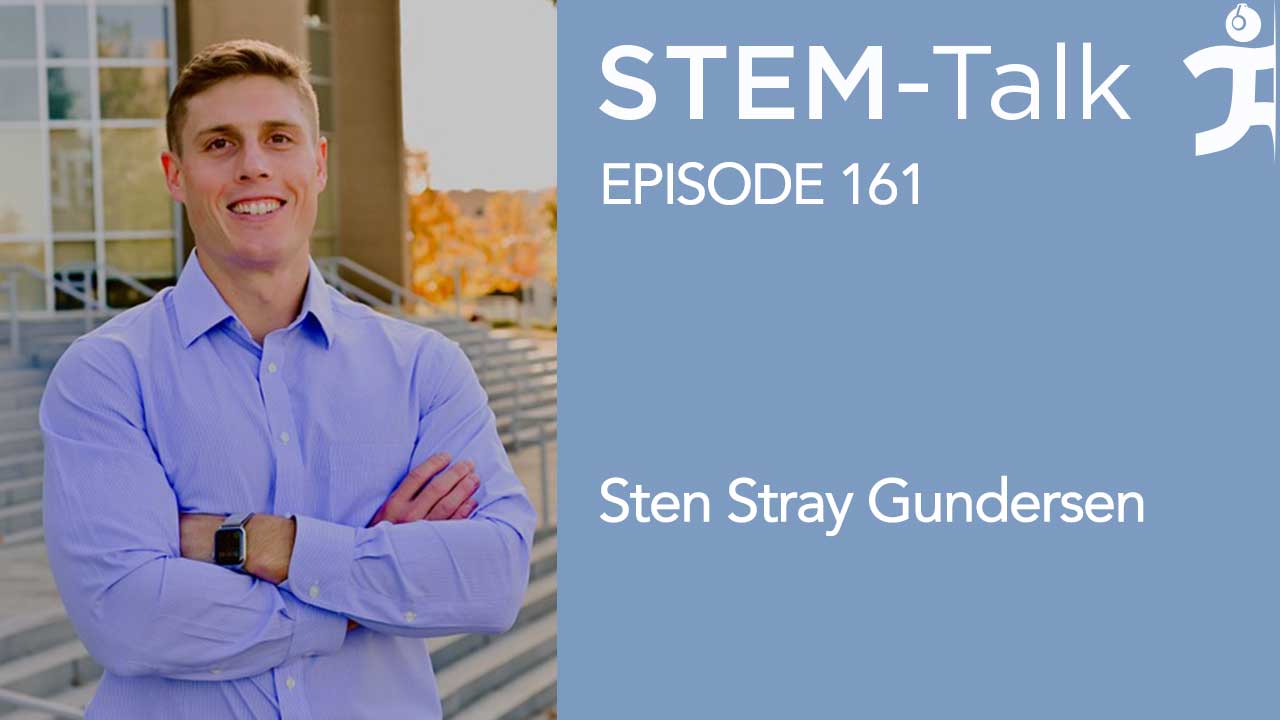STEM-Talk
Episode 161: Sten Stray-Gundersen on the benefits of blood-flow restriction training
// Dec 19, 2023

Today’s episode of STEM-Talk features Dr. Sten Stray-Gundersen, a post-doctoral research associate at the University of South Carolina who is also an adjunct instructor at the university’s Arnold School of Public Health.
Cohosts Dr. Ken Ford, IHMC’s founder and CEO, and Dr. Marcas Bamman, a Senior Research Scientist at IHMC, talk to Sten about his work on blood-flow restriction training and cardiovascular exercise physiology.
Prior to his position at South Carolina, Sten was a teaching assistant at the University of Texas where he earned his Ph.D.
Sten’s father, Jim Stray-Gundersen, was our guest on episode 34 of STEM-Talk in 2017. Jim, who passed away last year, helped pioneer blood-flow restriction training in the United States.
In today’s interview, we cover the documented benefits of blood-flow restriction and how it not only increases muscle strength, but also improves endurance and reduces the risk of injury. Sten also talks about his research into hypoxia and endothelial function.
Show notes:
[00:03:02] Sten begins the interview talking about the different places where he grew up. [00:03:32] Marcas asks if it’s true that Sten’s high school soccer team won three straight state titles. [00:04:06] Marcas mentions that Sten’s younger brother was also a good soccer player in high school, and was on the same team as Sten when they won their third state championship. Sten goes on to talk to talk about playing sports with his siblings. [00:04:43] Ken mentions that Sten was a nationally ranked speed skater and cross-country skier. Ken asks Sten about other sports he excelled at. [00:05:45] Marcas asks how Sten’s parents influenced his success in athletics. [00:06:41] Ken takes time to offer his condolences for the passing of Sten’s father, Jim Stray-Gundersen, who was interviewed on episode 34 of STEM-Talk. The 2017 interview, which focused on blood-flow-restriction training, remains a popular STEM-Talk episode to this day. [00:08:21] Marcas asks Sten about trying blood-flow restriction (BFR) for the first time with his father. [00:09:37] Marcas asks Sten what led him to become interested in pursuing a career in science. [00:10:27] Ken mentions that Sten went to Dartmouth for his undergrad on a soccer scholarship. After graduating, Sten attempted to play in the USL. and Ken asks how that worked out. [00:11:57] Marcas mentions that as Sten’s injuries from soccer piled up, he began to consider going back to school and pursuing research. Marcas asks what went into that decision-making process. [00:13:38] Marcas mentions that during Sten’s time in Austin, he worked for a group called ROI Performance, which is an evidence-based physical therapy center that focuses on athletic rehab and performance. Marcas asks Sten to talk about his time there as a BFR specialist. [00:15:23] Marcas takes a moment to explain that BFR training involves restricting the blood flow to specific muscle groups, using specialized cuffs or bands. Marcas asks Sten to explain how BFR allows people to train with lighter weights while still reaping many of the benefits associated with heavier resistance training. [00:16:20] Ken mentions that BFR has largely been associated with resistance training, but it is now being looked at in the context of endurance sports. Ken asks Sten to discuss how different protocols of BFR can be implemented to yield different effects in the contexts of resistance training and aerobic training. [00:19:10] Ken notes that much of the Western research on BFR has now incorporated the arterial occlusion pressure approach, so much so, that it is often promoted as the only safe and effective approach to BFR. Ken goes on to say that this is not how BFR was originally conceived. Ken explains that there are a variety of different approaches to BFR, each with tradeoffs, and asks Sten to discuss these issues in detail. [00:21:22] Ken mentions that clarity is lacking in much of the BFR literature, and that while some of it is no doubt good research, it’s hard to interpret because of the lack of standardization of protocols and equipment. Ken asks Sten for his thoughts. [00:22:16] Ken asks Sten to elaborate more on the mechanisms underpinning the benefits of BFR, particularly in the context of resistance training. [00:24:53] Marcas starts a discussion between Sten and Ken about the current elevated interest in lactate as a stimulant of exerkines, which are hormones, metabolites, proteins, and nucleic acids that are secreted in response to exercise. [00:28:34] Marcas asks about the different approaches to BFR between an elite athlete looking to gain a fractional advantage, versus a middle-aged or older person aiming to incorporate BFR to improve their health and functionality. [00:32:15] Marcas pivots to talk about some of the Sten’s studies, mentioning a paper Sten worked on while he was at Texas that compared the acute cardiovascular responses to two distinct forms of BFR during light-intensity exercise. Marcas goes on to mention that while BFR has become more popular over the last two decades, there have been some concerns raised about the use of BFR in at-risk populations. Marcas asks Sten about those concerns. [00:38:15] Ken notes that BFR in the form of Kaatsu has been practiced in Japan for more than 30 years with a very low rate of serious complications. Ken mentions that for those listeners interested in Kaatsu, they should listen to Sten’s father’s interview on STEM-Talk episode 34. Ken follows up by asking Sten to give a brief history of Kaatsu. [00:43:29] Marcas returns to talking about Sten’s previously mentioned study, where Kaatsu bands and wide-ridged cuffs were compared in their effects on the exercise of walking. Marcas asks Sten to explain how they conducted this study and what he and his colleagues found. [00:44:41] Marcas asks about a 2021 paper that Sten had in the European Journal of Surgical Oncology, where BFR training paired with nutrition was used to improve the physical function of abdominal cancer patients awaiting surgery. [00:47:53] Ken asks Sten to talk more in-depth about the structure of the previously mentioned study on abdominal cancer patients. [00:49:32] Marcas explains that ischemic heart disease is the most common form of cardiovascular disease and is a result of the weakening of the heart due to restricted blood flow. This is caused by plaque buildup in the major arteries. Marcas goes on to explain that treatments designed to restore blood flow to the heart can cause ischemia reperfusion injury. Marcas asks Sten to explain what ischemia reperfusion injury entails. [00:51:16] Marcas explains that Sten was part of a 2022 paper in the journal of applied physiology, which looked at intermittent hypoxia as a potential systemic strategy to prevent the reduction in flow-mediated dilation following ischemia reperfusion injury. Marcas asks Sten to give an overview of what intermittent hypoxia means in this context. [00:52:49] Marcas explains that Sten’s hypoxic preconditioning had some protective effects during ischemia reperfusion injury and asks Sten to talk more about the significance of this study. [00:56:26] Ken asks how Sten came to his current post-doc position at the University of South Carolina, in the sports science lab. [00:57:54] Marcas asks Sten what kind of projects he will undertake in the sports science lab. [00:58:56] Marcas asks Sten to explain how one can get into BFR training. Sten talks about where to get the specialized cuffs and bands and how to use them. [01:01:15] Marcas asks about a series of videos Sten did with Kathy Smith, a renowned video workout instructor from the ‘80s and ‘90s. In the video, Sten and Kathy demonstrate the use of the Be Strong BFR bands. [01:02:17] Ken asks Sten for his thoughts on the use of BFR training to prevent sarcopenia in older adults, especially considering that many seniors have compromised joints and can avoid pain and injury to their joints using lighter weights, while still stimulating an adaptive muscle response with BFR. [01:03:37] Sten closes the interview discussing some suggested protocols for BFR training.Links:






